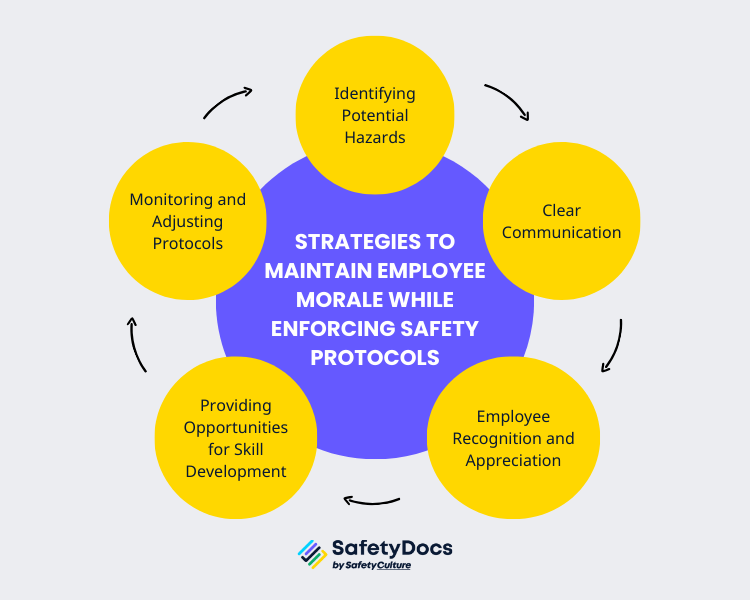Is it really necessary that your employee feels happy and satisfied at work?
72% of employed Australians have felt unhappy at work based on the 2022 Workplace Happiness Survey by Indeed/YouGov. An employee who is content and fulfilled is inclined to be highly motivated, productive, and deeply engaged in their work. This is why boosting employee morale is vital, especially when enforcing employee safety protocols. However, workplace safety should also not be compromised to maintain positive employee morale.
So, how do we balance employee morale with effective safety protocols? Balancing these two critical aspects is challenging but essential for a thriving and productive work environment. Let's delve into some key points that can help organisations strike the right balance.
What is Workplace Morale?
Workplace morale refers to the level of employee satisfaction and attitude that employees have towards their job, workmates, conditions, and their employers. It is a qualitative metric that has been strongly linked to employee engagement, productivity and, ultimately, an organisation's success. Employees who feel happy, respected, and valued at work are more motivated to perform better.
What Influences Employee Morale?
Several factors can affect workplace morale, including:
- Leadership: The role of leadership is fundamental in influencing employee morale. Influential leaders inspire their teams, foster a positive work environment, and lead by example. Micromanaging or unstable leadership, on the other hand, can negatively impact morale.
- Communication: Clear, open, and honest communication is crucial. Employees must understand their roles and responsibilities and how their work contributes to the organisation's goals. Lack of communication leads to confusion and lower morale.
- Reward & Recognition: Acknowledging and rewarding employees' efforts boosts morale. When employees feel appreciated, employee engagement, and motivation levels are significantly higher. Lack of recognition can lead to dissatisfaction and lower productivity.
- Healthy Work-Life Balance: A satisfactory work-life balance significantly influences employee morale. Overworking employees or not respecting their time can lead to burnout and decreased morale.
- Nature of Work: Employees tend to have higher morale when they find their work meaningful and fulfilling. If they see no purpose or value in what they do, it can lead to low employee morale.
- Workplace Benefits & Compensation: Competitive salary and benefits packages can enhance employee morale. If employees feel underpaid or if the benefits are inadequate, it could lead to dissatisfaction.
- Workplace Culture: The overall company culture of the workplace plays a significant role in employee morale. A positive, inclusive, supportive culture fosters high morale, while a stressful or negative culture can decrease it.
- Relationships with Co-workers and Leaders: Healthy relationships with colleagues and superiors contribute to high morale. On the other hand, conflict or lack of support can lead to low employee morale.
Why it Matters
1. Productivity
High morale often leads to employee satisfaction and increased productivity. Content and satisfied employees tend to be more motivated, perform at a higher level, and efficiently accomplish their tasks.
2. Employee Retention
Companies with high employee morale tend to have lower turnover rates. Employees are less likely to look for jobs elsewhere when they feel valued and appreciated at their current workplace.
3. Team Cohesion
Morale can significantly impact team member dynamics. In workplaces with high morale, there tends to be better cooperation, communication, and teamwork.
4. Job Satisfaction
High morale contributes to greater job satisfaction. Satisfied employees are more dedicated and committed to their jobs, which, in turn, benefits the company in the long run.
5. Employee Health
High morale can improve employee physical and mental health. Stress and anxiety levels are usually lower in workplaces with high morale, which can improve employee morale and result in fewer sick days and lower healthcare costs.
6. Customer Service
Employees with high morale are typically more customer-focused. They are more likely to provide excellent service, increasing customer satisfaction and loyalty.
7. Company Morale
Lastly, companies with high morale tend to have a positive internal and external reputation. This can attract high-quality candidates, business partnerships, and investors.

The Correlation Between High Morale and Safe Work Practices
Happy employees are often more compliant with safety rules and regulations. Companies with high morale have fewer accidents, injuries, and illnesses than those with low employee morale. This correlation is because satisfied, valued, and respected employees tend to have a positive attitude towards their work. As a result, they are more likely to adhere to safety protocols.
What are Safety Protocols?
Safety protocols are predefined procedures or processes to maintain a safe and healthy environment. They are established to minimise the risk of accidents, injuries, and exposure to harmful situations in workplaces, schools, public spaces, etc.
Here are some key elements of safety protocols:
- Risk Assessment: Before establishing safety protocols, a thorough risk assessment is often done to identify potential hazards in a particular environment.
- Preventive Measures: Safety protocols include preventative measures to reduce these identified risks. These could involve wearing personal protective equipment (PPE), following specific procedures when handling hazardous materials, or adhering to certain machinery rules.
- Emergency Procedures: Safety protocols also outline what actions should be taken in an emergency. This could include evacuation plans, first aid procedures, or steps to follow in case of a fire or chemical spill.
- Training: Thorough training plays a critical role in upholding safety protocols. All individuals within a specific setting must receive comprehensive training to foster comprehension and effective implementation of the protocols.
- Regular Reviews and Updates: Safety protocols should be regularly reviewed and updated to accommodate new risks or changes in the environment or operations.
- Compliance: Compliance with safety protocols is mandatory. Non-compliance can lead to disciplinary action and, in severe cases, legal repercussions.
However, it's also crucial to note that employees sometimes perceive enforcing safety rules as tedious or restrictive. Hence, maintaining high morale can help offset this perception and make it easier for employees to follow the rules.
Safety Violations Causing Low Morale
Low morale can sometimes lead to employees needing to respect safety protocols, leading to increased incidents and accidents. There are several reasons why this might happen:
1. Ignorance
Non-compliance often stems from a lack of knowledge or understanding regarding the associated risks. Regular training and constant reinforcement of safety protocols are essential in such cases.
2. Time pressure
Employees may feel pressured to prioritise productivity over safety in some industries or jobs. This often occurs in fast-paced environments where time is of the essence.
3. Lack of proper personal protective equipment (PPE)
Employees may feel unsafe and unprotected if they are not provided with the necessary PPE to perform their jobs safely.
4. Unqualified personnel working with dangerous tools
Employees may feel unsafe and anxious if required to work with dangerous tools or equipment without proper training or qualifications.
5. Poor lighting conditions
Poor lighting conditions can lead to accidents and injuries, negatively impacting morale.
6. Overtime
Overworking employees can lead to fatigue, stress, and burnout, negatively impacting and measuring employee morale and productivity.
7. Fear of retaliation
Employees may be afraid to report safety violations or concerns due to fear of retaliation, leading to low morale and a lack of trust in management.

Challenges in Maintaining Employee Morale while Enforcing Safety
Maintaining morale while enforcing safety can indeed be challenging. Several factors contribute to this:
1. Balancing Productivity and Safety
Employees might feel that strict safety protocols slow down their work, leading to frustration and decreased morale. Leaders must communicate that safety measures are in place to protect employees, not hinder their work.
2. Ineffective Leadership
For a safety culture to thrive, it must be led from the top. If a company culture or leadership doesn't embrace and practice safety measures, it can lead to confusion, inconsistency, and lower morale among employees. Workers will be less likely to follow safety protocols if they see their managers or supervisors flouting them.
3. Resistance to Change
Change can be difficult for many individuals, and implementing new safety protocols may be met with resistance. It's essential to communicate the rationale behind the change and involve employees in decision-making as much as possible.
4. Fear and Anxiety
Employees feeling unsafe or threatened at work can significantly lower morale. Leaders must ensure all team members have a safe working environment and promptly address any threats or violent behaviour.
5. Ethical Considerations
Ethical principles play a significant role in safety management. Leaders who demonstrate ethical behaviour, foster a moral climate, and implement ethical decision-making processes can positively impact safety outcomes and employee morale.
6. Training and Competence
Proper training is a critical part of safety protocols. Employees need to be adequately trained on these protocols to feel secure and anxious, which can affect employee morale. Ensuring employees are appropriately trained can minimise risk and also boost employee morale and confidence.
7. Burnout
Enforcing safety protocols can sometimes mean additional employee responsibilities, leading to increased workload and potential burnout. It's essential to manage workloads effectively, provide the necessary support, and recognise and reward employees' efforts to maintain morale during challenging times.

Strategies to Maintain Employee Morale while Enforcing Safety Protocols
Leaders can implement specific strategies to maintain high morale while enforcing safety protocols. These include:
Identifying Potential Hazards
Leaders must proactively identify potential hazards in the workplace and communicate them effectively to employees. This will help employees understand the rationale behind safety protocols and encourage compliance.
Clear Communication
Effective communication is key to maintaining morale while enforcing safety protocols. Leaders must communicate the importance of safety, the reasoning behind specific rules, and how they benefit everyone in the workplace.
Employee Recognition and Appreciation
Recognising and appreciating employees' efforts in following safety protocols can positively impact morale. This can include rewards, incentives, or even a simple thank you and acknowledgment.
Providing Opportunities for Skill Development
Employees who feel competent and skilled in their jobs are likely to have higher morale. Providing skill development and training opportunities can help employees feel more confident and secure while performing their tasks, leading to better compliance with safety protocols.
Monitoring and Adjusting Protocols
Leaders must continually monitor the effectiveness of safety protocols and make necessary adjustments to suit their workplace. This can involve seeking employee feedback and involving them in decision-making processes.
Robust HR Policies and Procedures
Implement transparent and fair HR policies, fostering an environment of trust and consistency. Regular policy reviews ensure they remain relevant and practical.
Mental Health and Psychosocial Support
Offer mental health support and stress management programs to address work-related pressures. Creating a supportive environment for mental health encourages open discussions and early intervention.
Diversity & Inclusion Policy
Promote a diverse workplace and practise inclusive communication. Celebrate different cultures and ensure safety protocols consider diverse needs, enhancing employee engagement and satisfaction.
Implement Strategies Effectively With SafetyDocs
Monitoring and enforcing safety protocols can take up a considerable amount of time and resources. SafetyDocs by SafetyCulture can help streamline the process with our safety documents, checklists, and templates. We have been providing safety solutions for Australian workplaces, and our products can assist executives in effectively communicating safety protocols, identifying potential hazards, and monitoring employee compliance.
You can start with the following templates to maintain high morale while enforcing safety protocols in your workplace:
- Safe Operating Procedures Templates
- Comprehensive HR package
- Diversity and inclusion Policy
- Psychosocial Hazards Management Plan
- Competency, Training & Awareness Plan
With SafetyDocs, maintaining morale while enforcing safety becomes more manageable, ensuring a safe and productive workplace for everyone. So why wait? Contact SafetyDocs today!
Our team of experts is dedicated to providing accurate and informative content. Craig Cruickshank, our senior HSEQ advisor at SafetyDocs by SafetyCulture has reviewed this blog post to ensure the highest level of quality.
Learn more about Craig's work on LinkedIn for more industry insights.
Available for instant download and supplied in fully editable MS Word format for use in your business.
Please note that the above information is provided as a comment only and should not be relied on as professional, legal or financial advice.
Share This Article
